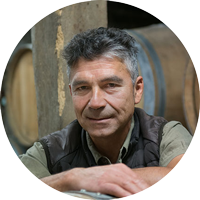
In 2007, the Cahors vineyard collectively adopted a new communication strategy called “Cahors Malbec”, which is still implemented today. The objective was clear: To become the capital of terroir Malbec.
But beyond that objective, which we could refer to as intermediary, the real ambition of the Cahors vineyard, for the last 20 years, is to be recognised as one of the great terroir wines of the world, irrespective of the grape variety.
To achieve that objective, winemakers invested in studying their terroirs in the 1990s. The aim was to understand their great diversity and become aware of their genuine potential. Of the 21,700 hectares listed in the Cahors AOC protected designation of origin in 1971, the study found that several thousand hectares could be classified as a 1st growth or even a Grand Cru. This is exceptional.

Maurin BERENGER
co-president of the UIVC
Concomitantly, Cahors winemakers and merchants implemented changes in their product lines, crafting more voluptuous wines, on the one hand, and wines with greater finesse and complexity, on the other hand. The qualitative and stylistic “Cahors (R)evolution” took on new life about 10 years ago, with the arrival of a new generation of winemakers.
This is why Cahors was the vineyard of the year in France in 2016, why the vineyard today attracts prestigious Argentinian bodegas and why, a few years from now, it will no longer be necessary to put such great emphasis on the Malbec variety on bottle labels, given that the word Cahors will be synonymous with a great Malbec-based terroir wine, like a Nebbiolo-based Barolo or a Pinot Noir from Burgundy, bearing in mind that the vineyard is targeting a niche market at the global level, not a mass market.

Pascal VERHAEGHE
co-president of the UIVC
The presidents
Maurin BERENGER
Pascal VERHAEGHE
The board Members
Maurin BERENGER
David GIRARD
Daniel FOURNIE
Mathieu MOLINIE
Pascal VERHAEGHE
Didier PELVILLAIN
Pascal PIERON
Julien TOUBOUL
The members of the general assembly
Maurin BERENGER
David GIRARD
Daniel FOURNIE
Mathieu MOLINIE
Arnaldo DIMANI
Dominique RESSES
Sébastien SIGAUD
Serge BOUYSSOU
Pascal VERHAEGHE
Didier PELVILLAIN
Pascal PIERON
Julien TOUBOUL
François PELISSIE
Olivier PIERON
Alain JANICOT
Sébastien PHILIPPOT
Juliette DUBERNET
Administrative manager
Aurore DEL VITTO
Head of Public relations and digital technologies
Armand DE GERARD
head of public relations and event management


Ensemble, pour une meilleure visibilité
18 avril 2024

Guide DUSSERT GERBER 2025 : Appel à échantillons
17 avril 2024



